The New York-based photographer Lois Conner’s work is featured on the masthead of this site and on that of China Heritage Annual, which was launched in March 2017.
Lois and I met in New York in the summer of 1996, and since then we have worked together on many projects (a list of our collaborations is given below). She made work in Wairarapa, New Zealand, when I first moved here in late August 2016, a selection of which has been published in these pages. In May 2017, she will participate in Featherston Booktown, showing a selection of her work in the Gallery of le Quartier Français, home of The Wairarapa Academy for New Sinology.
Lois Conner’s latest exhibition is at the Gallery of The Temple Hotel 東景緣, Beijing, from the 23rd of April 2017 is a collaboration with the M97 Gallery in Shanghai. The artist asked me to suggest a title the shows, and to write for the catalogue. She has kindly given me permission to publish the essay I wrote for her on the eve of the Beijing opening. The gallery also invited a Chinese writer to comment on Lois’s work, and I introduced them to an old friend, Xu Zhiyuan 許知遠, an essayist, publisher and founder of One Way Street. Zhiyuan opens his mediation — ‘Yesterday and Tomorrow’ 昨日與明日(see below) — with a quotation from Chinese Shadows by Simon Leys:
In handbooks on Chinese traditional painting, an advice commonly given to the artist who wishes to learn to paint trees is to sketch them in winter, for then, without the seductive yet confused and blurry effect of their leafy masses, through their stark nudity they can best reveal their inner structure and specific character.
Xu suggests that Lois Conner’s work reveals the ‘stark nudity’ underlying Beijing.
— Geremie R. Barmé, Editor, China Heritage
20 April 2017
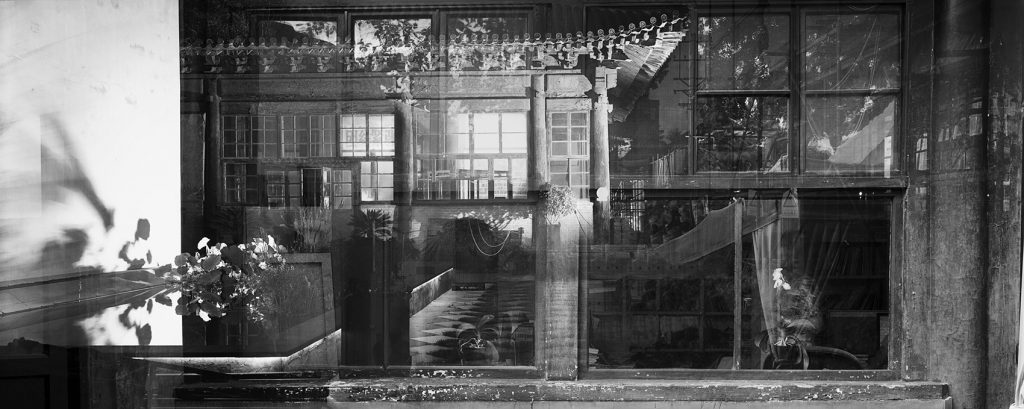
顛倒 Diāndǎo
Downside Up
From a distance the darkling form slowly comes into focus; it appears to be like a Skeksis from The Dark Crystal, the 1982 fantasy film designed by Jim Henson of Sesame Street and The Muppets fame. The Skeksis were creatures bent by the burden of their immense age, their elongated and haunted faces always hungry for more. (Henson based the Skeksis on an illustration of crocodiles done by Leonard Lubin for a book version of Lewis Carroll’s poem The Pig’s Tale.)

The Chinese incarnation of this creature, which has for over three decades appeared unannounced in the country’s bustling cities as well as in its rural backwaters, sports two solid hind legs and three spindly forelimbs on which it balances a formidable trunk. The hump between these extended limbs, the thing that first attracts the curious onlooker, flushes forward and culminates in a cyclops-like eye.
As others focus on it, the ungainly creature too focusses its attention. It would like nothing better than to disappear into the landscape across which its eye roams; to be free to take in the world in silence and at its own pace. But, by the very nature of its craft, the photographer who is obscured under a focussing cloth — giving the impression of being a Sino-Skeksis — attracts the unwarranted attention of crowds. Often, when she unsheathes herself ready finally to make her work, the photographer looks up to find herself surrounded. The game is up.
***

Lois Conner uses a banquet camera, a modern version of a nineteenth-century camera employed by photographers to make pictures of people massed together at such occasions as banquets because of its breadth of vision. It allowed for an elongated frame that could eliminate the distractions of the ceiling and the floor. First drawn to this format as an arts student at Yale University after she studied the landscape scroll paintings of the Ming dynasty, Conner has been using the format of the panoramic camera to pursue her work in China since 1984. The vistas embraced by the banquet camera allow her to ‘unfurl the landscape’ in a manner suggested by the scroll paintings.
The world that the artist sees through the flat plane of the ground glass under the ‘dark cloth’, as it is also known, be it megalithic limestone formations or intricate manmade structures, ancient monuments, the crowd in the street, or intimate portraits, is a topsy-turvy realm. Here, hidden under the cloth, everything that to the causal eye appears as upright and quotidian is inverted, all that is left-to-right becomes right-to-left. It is the world on the down low.
***
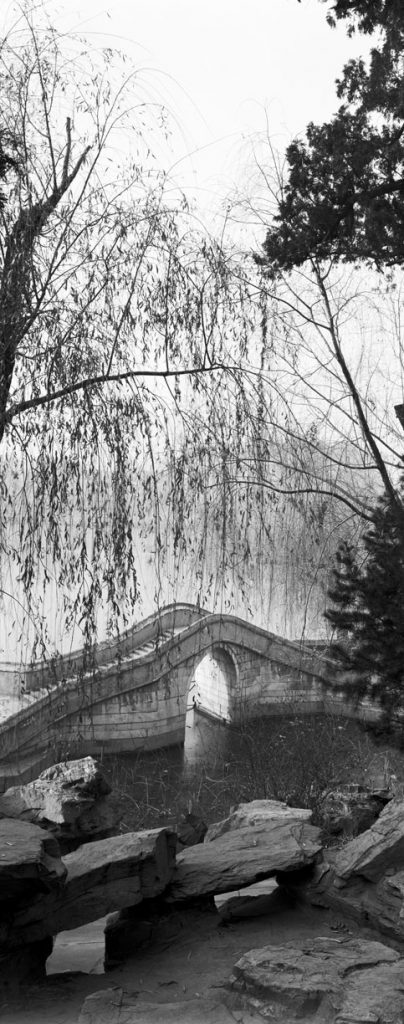
Diāndǎo 顛倒, the term means ‘upside down’. It frequently appears in the expression ‘turning black and white on their head’ hēibái diāndǎo 黑白顛倒. In other words, transposing one reality for another, when creating a fake world out of the real and a real world out of the fake.
From the earliest days that I worked with Lois Conner on a project related to the Garden of Perfect Brightness 圓明園 — the ruined imperial garden-palace in northwest Beijing — when she invited me to peer under the cloth and see the downside back-to-front world of the ground glass of her camera, I have frequently thought of the most famous line from China’s most celebrated novel, The Story of the Stone 石頭記, translated by David Hawkes:
Truth becomes fiction when the fiction’s true;
Real becomes not-real when the unreal’s real.
無為有處有還無
假作真時真亦假
Although the world seen through Lois Conner’s hooded ground glass plane is inverted and turned around 180 degrees, it still appears under the cloth in all the variegated hues and colours of our everyday reality. Cloaked inside her camera obscura, she focusses, then surfaces from the focussing cloth to put the film holder in place of the ground glass. The image in the ground glass is now drawn on the exposed negative, the light literally turns black and white on its head. When a print of the kind we see in this exhibition is made from these negatives, black literally turns to white and white to black: hēibái diāndǎo 黑白顛倒. The downside up world is righted once more, and through the process Lois Conner’s artistic vision finds form.
Some of Conner’s work is literally ‘crowd sourced’, as a scene she has fixed in her sights might turn on her — that Skeksis-like form of photographer hidden under the focussing cloth — becomes itself the focal point of the people within the landscape. The downside turns up as what was the order of her art is upended by the unpredictability of the real world. The curiosity can be a boon to the artist in many ways; roiling crowds can create a dynamic all of their own, and it can be hard for the lone artist to pursue a singular vision. Surfacing from underneath her dark cloth, Conner often finds herself surrounded, by faces, smiles and curiosity. Sometimes she responds by making her observers the observed, inviting the impromptu audience to participate as subject-collaborators.

***
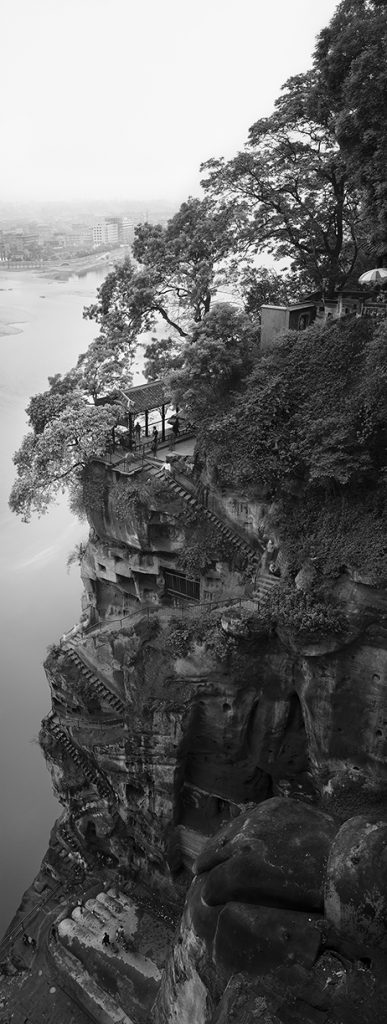
Diāndǎo, Downside Up, the term also occurs in the expression bǎ bèi diāndǎode lìshǐ zài diāndǎo guòlái 把被顛倒的歷史再顛倒過來: ‘upend a history that itself has been turned on its head’.
Over the decades that Lois Conner has been creating work in China, she has witnessed the transformations wrought in that country by the policies of the Open Door and Reform. It is an era that has seen the People’s Republic literally, and physically, turning history on its head. Starting with the years of the 1980s during which many of the distortions of the past were set right, or at least turned downside up; through the 1990s when policy-induced poverty was gradually replaced by expanding prosperity; in the new millennium when the physical heritage of the past has been codified, cleaned up and made more accessible, and acceptable, as the vision of an impossible future has too often been realised in the steel and concrete of massive cities and their conurbations. History has been upended and reality transformed; a once static world has become dynamic and mutable. Conner’s captured visions include transient moments as much as stories of longevity.
Much of the work in this exhibition was made in North China. It was, however, in the southern landscapes of Guangxi province, in particular amidst the monumental karst mountains near Guilin, that Conner was able to expand her original vision of Ming dynasty China through the lens of the modern panoramic camera.
Chinese historians have remarked that over the millennia it has often been the case that while ‘imperial power expands from the north to the south; cultural change moves from the south to the north’. That has certainly been the case in the China that Conner has worked in and grown with as an artist since the early 1980s. She has travelled from south to north and back again numerous times as she weaves the worlds of China — modern and traditional, natural and manmade — into an ever-growing body of work that embraces the past, constantly touches on the present, and addresses itself to the future.
***
Diāndǎo shìfēi 顛倒是非: it is a famous formulation dating from the time of the Tang-dynasty writer Han Yu 韓愈 in the eighth and ninth centuries. It is has been in currency ever since: ‘Truth and falsehood are turned on their heads’. A commonplace expression in colloquial Chinese, it is also an encapsulation of the upended world of modern times. Under Lois Conner’s focussing cloth, however, the upside down, left-to-right inverted world is put to rights; her artistry creates a falsehood that tells the truth.
Note
The quotation is from Cao Xueqin 曹雪芹, The Story of the Stone: The Golden Days, translated by David Hawkes, vol.I, p.55. This book is also popularly known as The Dream of the Red Chamber 紅樓夢.
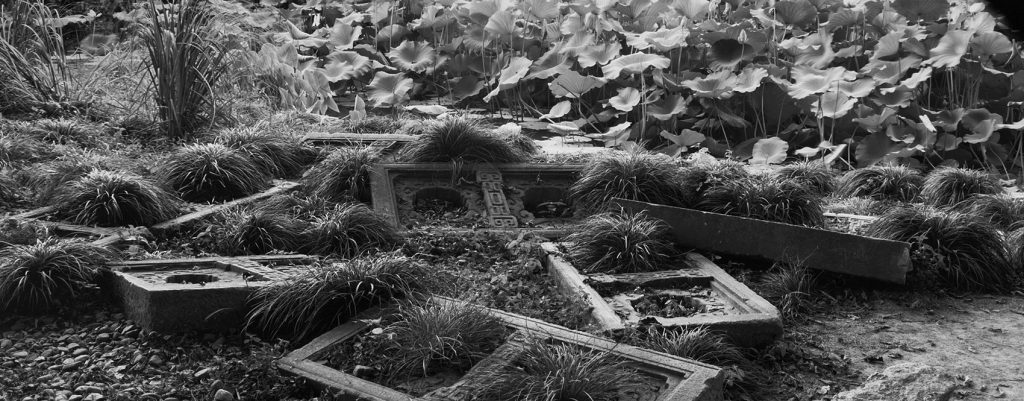
昨日与明日
许知远
在四十年前的一本书中,洞察力非凡的汉学家李克曼,曾谈到中国传统的绘画手册对于想描绘树木的艺术家的建议,他们应该在冬天动笔,因为“茂盛的树叶虽然诱人,但它也令人迷惑,看不清它的真实面目。只有去画那些光秃秃的树,才能把它们的内部构造、特质表现出来”。
当观看Lois Conner关于北京的作品时,我想起了这个插曲。她的对象不是冬日之树,而是一个人群散去的北京——紫禁城的一角,圆明园的盛开莲花、国贸写字楼中一件空办公桌,还有干面胡同里四合院的屋顶……即使偶尔出现人物,他们也是以作为景物出现的。而北京城,它的容貌与情绪,也在这样的镜头中逐渐浮现出来。
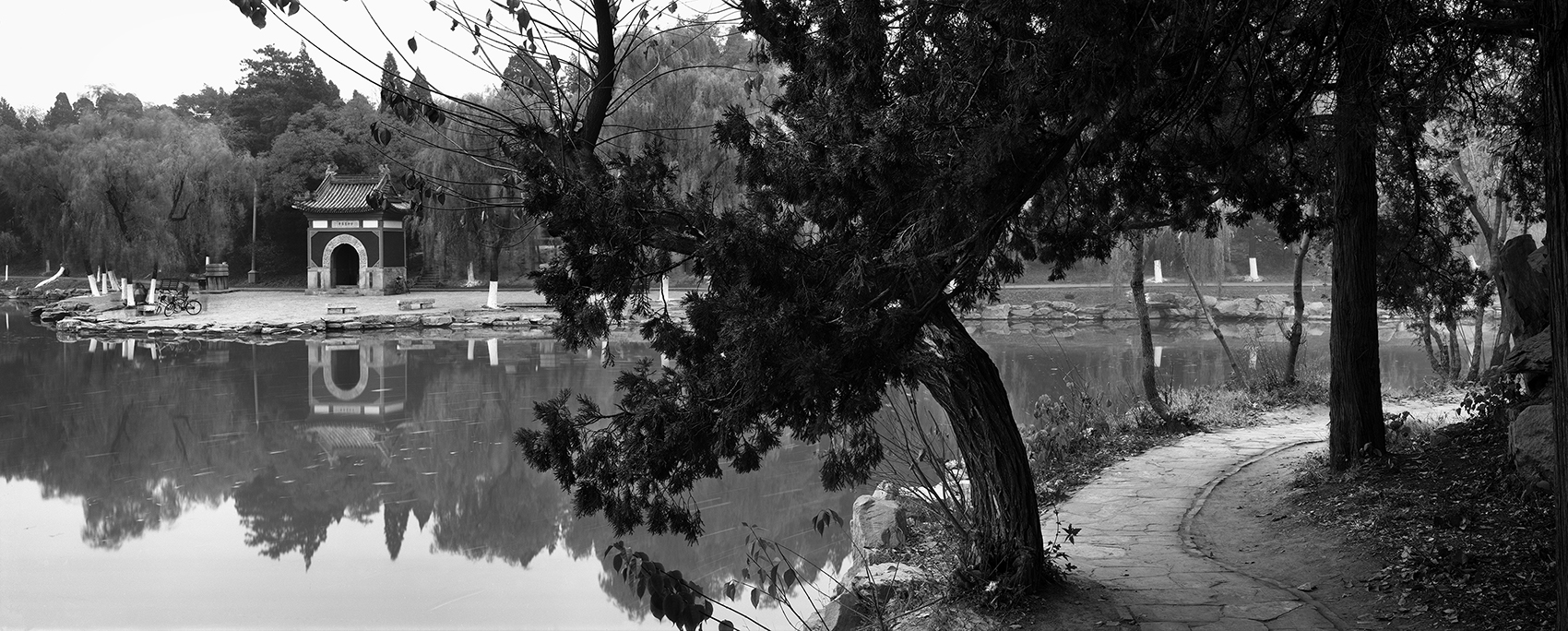
这是一个怎样的北京?对我而言,再没有北京大学的未名湖的角落,更代表这一切。在照片中,有岛上的松树,对岸的残存的花神庙门,还有一旁的自行车。这张照片摄于1998年,那正是北京大学建校一百周年之际。这座校园可以追溯到乾隆时代,花神庙正是他的宠臣和珅所建。1919年,美国人司徒雷登在建立了燕京大学,而如今正在庆祝百年的北京大学则是1952年移居此处,它是国家力量强制性的“鸠占鹊巢”。如果我记得没错,花神庙门不远处还有Edgar Snow的墓碑。这位美国记者曾在燕京大学任教,他的《红星照耀中国》一书,极大的帮助了中国共产党政权的兴起,这个政权又最终关闭了燕京大学。
清帝国、中华民国、中华人民共和国,几个世纪的历史以及它们的内在脉络,就这样安静、不经意的重叠这张照片中。1998年时,我是北京大学读书,常骑着照片中类似的自行车,在未名湖旁游荡。我很少对这重叠的历史发生兴趣。我这一代人接受的“去历史化”的教育,尽管习惯性的夸耀五千年的历史,但我们却对此一无所知,也毫无兴趣。吸引我们的是未来。未来又是什么?对我的父辈是苏联,对我们来说,是美国。
北京也成为了未来。在2008年北京奥运会以令人瞠目的登场后,它又成为21世纪国家资本主义的象征,一股不可阻挡之动力的代表。在Lois Conner的镜头中,兴建中的CCTV大厦正式这股新动力的表达。一个反叛性的荷兰建筑师完美的镶嵌于一个有国家意志与资本主义共同构造的、无所不包的权力系统中。
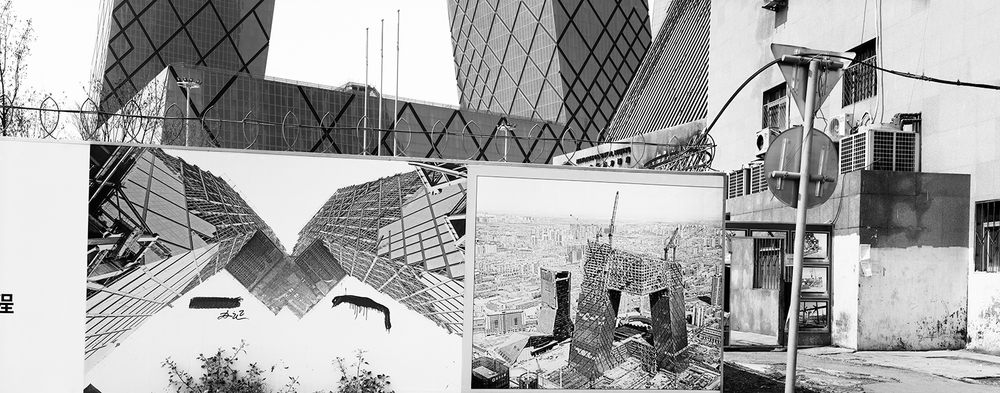
但这个未来能够持续多久?Lois Conner钟爱的圆明园曾是18世纪最辉煌的建筑,代表着令欧洲人惊叹的“中国模式”。但如今,它成为了令人哀伤的废墟。昨日与明日,经常象是硬币的两面,它们看似截然不同,又比肩而临。
李克曼在四十前的那本书名为《中国的阴影》,他在被西方汉学家、新闻记者所赞誉的文化大革命中看到了巨大的阴影。今天,Lois Conner则让我看到亢奋、扩张、自以为是的北京的另一面,它被遗忘的往昔,孤独、静谧与没落之美。
***
This is the original, unexpurgated version of Xu Zhiyuan’s essay.
The author’s use of Simplified Chinese Characters has been respected.
— The Editor
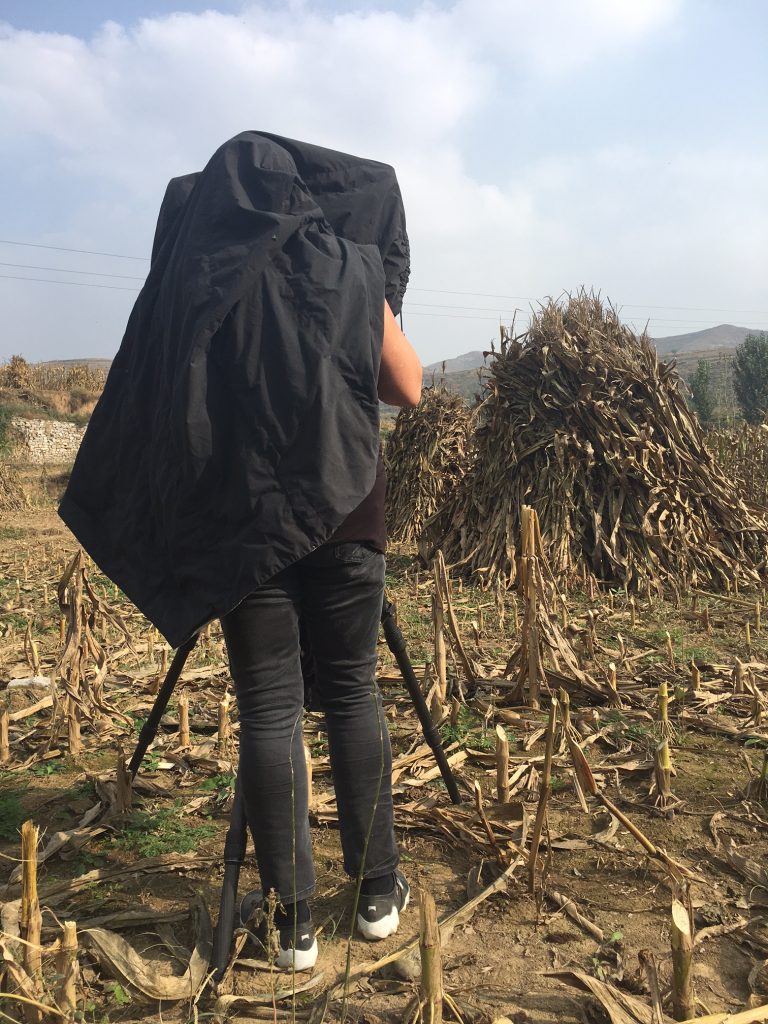
Lois Conner and Geremie R. Barmé collaborations
- The Garden of Perfect Brightness, a life in ruins, 1996
- China: The Photographs of Lois Conner, New York: Callaway, 2000 (essay)
- Lois Conner exhibition, Sherman Galleries, Sydney, 2001, catalogue
- Twirling the Lotus: Photographs from Tibet and China, 2007 (essay)
- Life in a Box, 2010 (essay)
- Beijing Building, London: Rossi & Rossi, 2011 (essay)
- Works by Lois Conner featured in the Australian Research Council Federation Fellowship Office, later the offices and corridor occupied by the nascent Australian Centre on China in the World (CIW), Coombs Building, Australian National University, 2006-2014
- China Heritage Quarterly: annual masthead images, 2009-2012
- China Heritage Quarterly: photographic essays in issues focussed on The Garden of Perfect Brightness; Beijing; Shanghai; and, West Lake
- Lois Conner’s review of Felice Beato — a Photographer on the Eastern Road for China Heritage Quarterly
- China Story Yearbook 2012: Red Rising, Red Eclipse, cover image
- The China Story Gallery, 2012-2014
- Beijing, contemporary and imperial, Princeton Architectural Press, 2014
- ‘Beijing, an unfolding landscape’, Inaugural CIW Exhibition, exhibition and catalogue, May 2014
- Works by Lois Conner in the Australian Centre on China in the World, 2014-2015
- A painting by Zhang Peili 張培力 donated to the Australian Centre on China in the World on 26 August 2016 by Lois Conner to celebrate the creation of the Centre
- China Heritage, masthead, 2016
- A New York Eye on The Rapa, China Heritage
- China Heritage Annual 2017: Nanking, masthead, 2017
- 顛倒 Downside Up, exhibition title and essay, March 2017
- Exhibition at le Quartier Français, Featherston Booktown, South Wairarapa, 13-14 May 2017
- New Sinology Reader, masthead, 2018

